
The Dilwara Temples or Delvada Temples are a group of Śvētāmbara Jain temples located about 2+1⁄2 kilometres from the Mount Abu settlement in Sirohi District, Rajasthan's only hill station. The earliest were built by Bhima I and supposedly designed or at least financed by Vastupala, Jain minister of Dholka. They date between the 11th and 16th centuries, forming some of the most famous monuments in the style of Māru-Gurjara architecture, famous for their use of a very pure white marble and intricate marble carvings. They are managed by Seth Shri Kalyanji Anandji Pedhi, Sirohi and are a pilgrimage place for Jains, and a significant general tourist attraction. The Dilwara temples are regarded as the most impressive among Jain temples in Rajasthan.

Bhiwani district is one of the 22 districts of the northern Indian state of Haryana. Created on 22 December 1972, it was the largest district of the state by area, before the creation of Charkhi Dadri as a separate district, as it occupied an area of 4,778 square kilometres (1,845 sq mi) and administered 442 villages with a population of 1,634,445. Sirsa is now the largest district of the state.

Karauli is a city located in the Indian state of Rajasthan. It is located in the Braj region and holds religious importance in Hinduism. The city is the administrative center of Karauli District, and was formerly the capital of the erstwhile princely state of Karauli. Karauli District comes under Bharatpur Divisional Commissionerate.
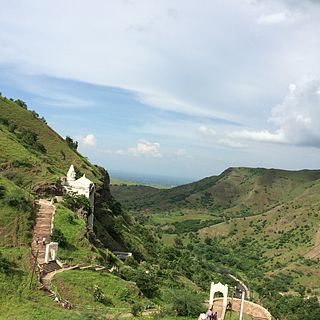
Bawangaja is a famous Jain pilgrim center in the Barwani district of southwestern Madhya Pradesh in India. Located about 6 kilometers south of River Narmada, its main attraction is the world's second largest megalithic statue of Lord Rishabhadeva, the first Jain Tirthankara. The statue is 84 feet (26 m) high. The center is located in the Satpura Range and is about 8 km from a Barwani town.

Mangi-Tungi is a prominent twin-pinnacled peak with plateau in between, located near Tahrabad about 125 km from Nashik, Maharashtra, India. Mangi, 4,343 ft (1,324 m) high above sea level, is the western pinnacle and Tungi, 4,366 ft (1,331 m) high, the eastern. Mangi-Tungi is 30 km (19 mi) from the city of Satana.
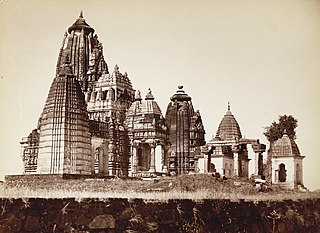
The Jain temples of Khajuraho are a part of the UNESCO World Heritage Site of Khajuraho. They are located in Chhatarpur district, Madhya Pradesh, India, about 175 kilometres southeast of the city of Jhansi.

Ranakpur Jain temple or Chaturmukha Dharana Vihara is a Śvētāmbara Jain temple at Ranakpur dedicated to Tirthankara Rishabhanatha. The temple is located in a village of Ranakpur near Sadri town in the Pali district of Rajasthan.

Jina Kanchi Jain Math, Melsithamur, is a Jain Matha that is located near Gingee, Villupuram district, Tamil Nadu, India.

The Palitana temples, often known only as Palitana, are a large complex of Jain temples located on Shatrunjaya hills near Palitana in Bhavnagar district, Gujarat, India. Also known as "Padliptapur of Kathiawad" in historic texts, the dense collection of almost 900 small shrines and large temples have led many to call Palitana the "city of temples". It is one of the most sacred sites of the Śvetāmbara tradition within Jainism. The earliest temples in the complex date as far back as the 11th century CE.
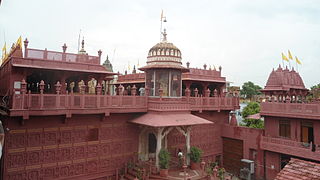
Shri Digamber Jain Atishya Kshetra Mandir, Sanghiji is an ancient Jain Temple in Sanganer, Rajasthan made of red stone. The ancient Shri Digamber Jain temple of Sanganer is 16 km from Jaipur.

Ancient idols of Jain Tirthankara were found in archaeological expeditions in Badli, Bhiwani, Dadri, Gurgaon, Hansi, Hisar (Agroha), Kasan, Nahad, Narnaul, Pehowa, Rewari, Rohad, Rohtak and Sonepat in Haryana. Agrawal Jain community traces its origins from Hisar. Guptisagar Dham Tirtha at Ganaur is a religious tourist spot in Haryana. It is named after the Jain Acharya Guptisagar.

Adinatha temple is a Jain temple located at Khajuraho in Madhya Pradesh, India. It is dedicated to the Jain tirthankara Adinatha, although its exterior walls also feature Hindu deities. This temple is part of UNESCO World Heritage Site along with other temples in Khajuraho Group of Monuments.
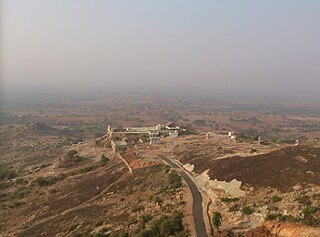
Kanakagiri Jain tirth kshetra also known as Kanakadri and Hemantha Desha is situated at about 3 km from Maleyuru, Chamarajanagar district, 53 km from the Mysore city and 182 km from Bengaluru.

Jain hoysala complex in Halebidu, Hassan district consists of three Jain Basadis dedicated to the Jain Tirthankars Parshvanatha, Shantinatha and Adinatha. The complex is situated near Kedareshwara temple and Dwarasamudra lake. The temple complex also includes a step well called Hulikere Kalyani.

The Hansi hoard was discovered accidentally by children looking for a ball, when they discovered one of the images on January 19, 1982. Hansi is located in the Hisar district of Haryana state, India. Archaeological Survey of India then excavated the completely hoard in 1982. It contained 58 bronze images of Jain Tirthankaras inside Asigarh Fort dating back to the 8th—9th century, as determined by paleographical analysis, although none of the images are dated.

Vidisha is considered to be Puranakshetras Jain tirtha. The Jain temples are located in Vidisha district in state of Madhya Pradesh, India. According to Jain belief, Vidisha is the birthplace of Shitalanatha, the tenth tirthankar. Here the first 108 feet elevated temple with all Tirthankaras with Shitalanatha as the principal deity is under construction.

Maladevi Temple is a Jain temple located in Gyaraspur town of Vidisha in state of Madhya Pradesh, India.
In 1956, 240 Jain bronze idols were discovered dating back to early medieval to medieval period. The Vasantgarh hoard, thus named after the place of discovery, Vasantgarh is located in the Sirohi District of Rajasthan, India.
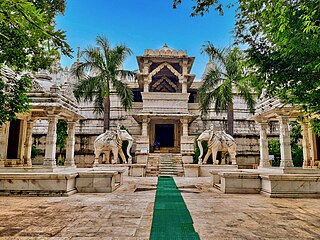
The Kumbharia Jain temples is a group of five Jain temples in the Kumbhariya, Banaskantha district in Gujarat, India. Constructed from 1062 to 1231 CE during the reign of the Chaulukya dynasty, they are noted for their elaborate architecture.






















